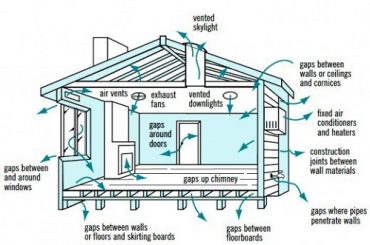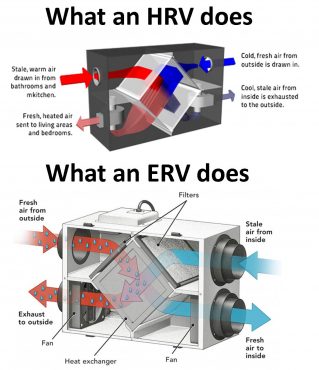
John Bleasby
Change is in the Air!
Canadian ContractorDeveloping an Interior Air Quality (IAQ) strategy goes hand-in-hand with today’s tight houses
Part Two of our series “The 3 columns of Support for Net Zero Energy-ready”.
Canadian Contractor examines the bond between tight homes and Internal Air Quality. Understanding their relationship is critical for contractors and renovators over the next decade, as Net Zero Energy-ready homes become the building code standard.
Ever-tighter building envelopes and dedicated air ventilation systems go hand-in-hand. That’s because air changes per hour are dropping, as insulation techniques and window and door technology improve. To put numbers on it, air changes per hour are dropping from 3.0 – 4.0 in current new houses, to 1.0 – 1.5 in NZE-ready pilot projects. And if you think that is dramatic, consider that most poorly insulated homes built prior to the 1980’s are rated around 30 to 40 air changes per hour. What this means is that air freshness and humidity control in today’s and tomorrow’s homes can no longer rely on the ‘leaky houses’ approach — Internal Air Quality need to be controlled and monitored 12 months of the year, and in changing environmental conditions. At stake is the health and living comfort of the occupants.
Research into IAQ at the federal level is reshaping previous thinking
Boualem Ouazia, Research Officer with Natural Resources Canada’s Indoor Environment Research Program, has been part of a 15-year study investigating ventilation and air replacement issues surrounding homes today. At the Buildings Show in Toronto last November, he described of four ways to approach to issue of interior air quality: Natural, Mechanical Exhaust, Supply side, and Balanced.

Existing housing stock built prior to the 1980’s are ‘Leaky Houses’, with potentially up to 30 – 40 air changes per hour measured
Natural air ventilation is a nice way of saying ‘leaky house’. It can mean a poorly insulated older house, or perhaps an ‘open window’ strategy in a newer house. However, it’s haphazard and barely a strategy at all; there are no dampers to control fresh air intake and stale air exhaust, and no method of controlling humidity levels.
Some might argue that Mechanical Air Exhaust, such as the regular use of bathroom and kitchen exhausts, will do a satisfactory job of removing stale or humid air. However, in seasons when windows and doors remain closed, negative air pressure can develop, little fresh air can enter the home, and humidity is neither monitored nor controlled. In fact, any negative air pressure resulting from this one way flow can cause cold outside air to be sucked into the home from outdoors through cracks or openings, not only reducing energy efficiency but also increasing the risk of harmful auto exhaust and chemical fumes entering from garages.
Dependence on Supply Side air Intake by simply running the finance fan continuously means a reliance on the air drawn from outside that feeds a forced air home heating system. The key missing element is air exhaust —when the furnace is not heating, continuously running the furnace fan just recirculates the same air around the house. When the fan runs with the furnace, any resultant positive air pressure has the potential to push humid air into the far corners of a home, such as the exterior walls inside closets, corner bedrooms and windows, where it can form harmful mold.

An Energy Recovery Ventilator (below) goes one step further than a Heat recovery Ventilator (above) by managing moisture as well as heat.
The Balanced Interior Air Quality (IAQ) approach is the correct approach, by means of a Heat Recovery Ventilator system (HRV). An HRV is a continuous fresh air replacement system that can be either stand-alone with its own ducting or incorporated as part of a forced air system. Also making an impact are the more sophisticated Energy Recovery Ventilator systems, or ERV’s, which Ouazia recommends in extreme northern regions of the country that have been the focus of his most recent studies, and warm humid climates.
HRV or ERV? Understanding the difference
An HRV recovers the heat before it exhausts outside, using that heat to preheat incoming fresh air. This reduces the energy required to bring outside air up to ambient room temperature. This is important in central Canada where seasonal temperatures can be extreme. An HRV also plays a crucial role in the removal of contaminants. These include toxins and excess humidity emitted by human occupants, chemicals in building materials and furnishings that continue to off-gas for many years after installation, plus the harmful buildup of mold.
An ERV, however, does this and more; it recovers heat like an HRV but it also recovers and transfers moisture as air moves through its core. It’s a key difference, and one that makes the choice between an ERV and HRV dependant on location, according to Wayne Fischer, Ontario Sales Manager for Lifebreath, one of Canada’s leading air quality equipment manufacturers. “An ERV would make much more sense in Vancouver than Saskatchewan, say, because the winters are warmer and there’s more coastal humidity,” Fischer told Canadian Contractor. “The ERV is really a summertime humidity advantage. In summer time, as humid air is drawn into the house, the humidity will be transferred at the ERV’s core to the outgoing cool dry air stream, so that moisture will not come into the house and overload the air-conditioner. The result is a drier house during humid summer periods without making the air conditioner work too hard.” Houses equipped with humidifiers could also benefit in winter since an ERV will retain rather than expel that added humidity.
“In the past, HRV’s were the way to go because they are strong and robust,” Fischer said. However he notes that the future of ventilator systems may lean towards ERV’s. “ERV’s are becoming more dependable in cold weather. We also have housing technology that’s improving; heat loads are going down, cooling loads are becoming more of a factor. The ERV is starting to make more sense.”
Homes built to today’s higher standards of insulation will require contractors to have a better understanding of how air quality impacts the health and comfort of the occupants.
Canadian Contractor continues the conversation with Wayne Fischer in the next part of this series, with important questions and answers from this industry expert.
Read previous installments of this series
Part 1: Sealing the Envelope
Part 3: Questions & Answers On IAQ and negative air pressure
Got feedback? Make your opinion count by using the comment section below,
or by sending an email to:
JBleasby@canadiancontractor.ca
Follow John on Instagram and on Twitter for notifications about his latest posts

![]()

Leave a Reply